
|   |

|   |
Sanjukta Panigrahi Yuva Mahotsav 2023 - Lekha Merchant e-mail: lekhamerchant@hotmail.com Photos: Girish Nambiar September 10, 2023 The 20th Sanjukta Panigrahi Yuva Mahotsav was held at Veer Savarkar auditorium in Mumbai on August 25, 2023. It began with the recitation of the first stanza of Jagannath Ashtakam in praise of Lord Jagannath, the presiding deity of Odissi. This festival was organized by Smitalay, the Odissi dance institute started by Guru Jhelum Paranjape. In the beginning, Jhelum tai (as she is called by many) came to the podium and talked about how she thought of having this festival every year. She wanted to keep the memory of Sanjukta Panigrahi alive and fulfill Panigrahi's dream of encouraging young dancers. With this thought behind it, the festival has grown in stature and this year seventy-eight dancers applied to dance on this platform. Eight were chosen. 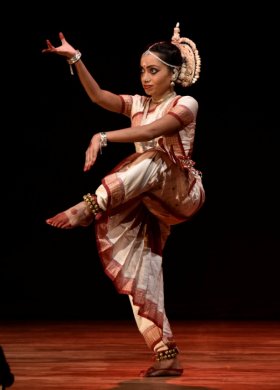 Rupali Kadam, Odissi dancer Rupali Kadam, a disciple of Guru Jhelum Paranjape and a B grade artist of Doordarshan was the first performer. She danced on the Shiv Tandav Stotra choreographed by Guru Kelucharan Mohapatra with music composed in raag Bhairavi in khemta taal by Pandit Bhubaneswar Mishra. Rupali's was a strong and fiery performance. The sound of her strong footwork reverberated through the auditorium as she danced around the stage in the item on Shiva. Her dance had a mesmerizing quality about it. Then she performed the Singhendra Pallavi in taal triputa choreographed by Guru Kelucharan Mohapatra with music composed by Pandit Bhubaneswar Mishra. This pallavi is known for its intricate rhythm patterns and speed. She did full justice to the choreography, completing every torso movement at the precise moment with accurate footwork. 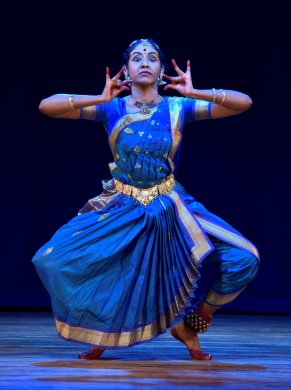 Aparna Shastry, Bharatanatyam The second performer for the evening was Aparna Shastry, a Bharatanatyam dancer and disciple of Guru Radha Sridhar of Bangalore. She began her performance with the Saraswati kauthvam in raag Vageshwari, taal adi and choreographed by Guru Shankar Kandaswamy. She performed with easy grace, effortless movements and her subtle abhinaya extolled the virtues of Devi Saraswati as the very source of the Vedas. Her second piece was a Devaranama by Purandara Dasa. It was based on raag Shivaranjani in adi tala and choreographed by Guru Radha Sridhar. This piece talks about the dual nature of the Lord, who is both compassionate and an annihilator of evil. Aparna with her measured but strong abhinaya brought to life the Narasimha avatar of Vishnu and the Krishna Arjun Samvaad. 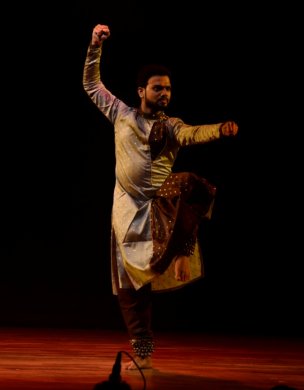 Gauresh Shetkar, Kathak Then came Gauresh Shetkar, a Kathak artiste from Pune. His presentation had a lot of variety. He began with a Krishna Vandana "Kasturi Tilakam" in raag Khamaj beautifully choreographed by Shambhavi Dandekar. In the taal section, he chose to perform on compositions set by Pandit Suresh Talwalkar. His footwork was very clear. In the end, he performed a piece on Ravana, choreographed by his Guru Amruta Paranjape. He actually transformed into the mighty Ravana and took the audience through Sita Swayamvar, Sita haran, Jatayu Vadh and to Mount Kailash, Shiva and Parvati's abode and lifted and shook the mountain. The audience sat spellbound. They could not move their eyes off the stage even for a short while. Gauresh got a thunderous applause for his performance. 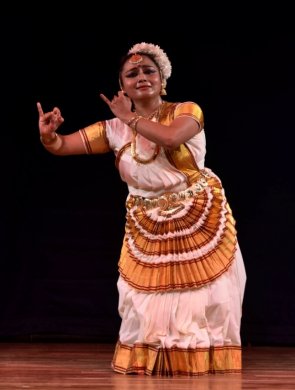 Chitra Warrier, Mohiniattam The fourth artiste for the evening was Chitra Warrier, a Mohiniattam dancer from Bangalore. She performed a padam and a varnam, both choreographed by her Guru Udyogamandalam Vikraman Pillai. The padam was in praise of Lord Ganapathy and set in raag Arabhi and adi taal. The varnam was composed by Maharaja Swati Thirunal in ragam Todi and adi taal. The varnam is all about despair, the nayika lamenting and missing her Lord Padmanabha. 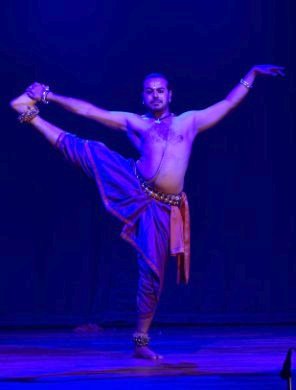 Krishnendu Saha, Odissi Krishnendu Saha is a student of Guru Sharmila Biswas and a promising male Odissi dancer of the country. He began his performance with a piece called Avahani or invocation. This piece is about invoking the divine in the dancer for an auspicious beginning. This piece had a lot of Yoga postures interwoven with dance. Krishnendu did full justice to his Guru's choreography. The music for this piece is a collection of chants by practicing priests of Odisha set to rhythm by Bijay Kumar Barik and Sangeeta Gosain. He then performed the Dashavtar of poet Jayadeva. This piece explored the evolution of life on earth from fish to human beings. This was a vigorous and powerful performance. The music and the dance of lights added to the magic. This piece was choreographed by Guru Sharmila Biswas and the music was created by her with Srijan Chatterjee. Fifteen different traditional percussion instruments from Odisha have been used in this music along with Jodi Shankha and muhuri. 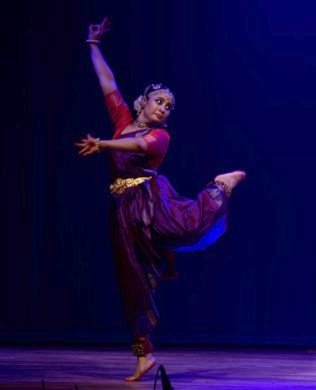 Ayana Mukherjee, Kuchipudi The next performer was Ayana Mukherjee, a Kuchipudi dancer from Delhi, who is under the tutelage of Guru Vanashree Rao for the past eight years. She performed two pieces, both dedicated to Shiva. The first, "Mahadeva Shiva Shambho" describes Shiva as Mrityunjaya and portrays the fierce Lord Shiva who is able to snatch the life of his devotee Markandeya from Yama himself. Ayana portrayed the Raudra swaroop of Shiva. This piece was choreographed by Guru Vanashree Rao in adi talam and raag Revati. The second piece was choreographed by Ayana herself. It was dedicated to Shiva as Gopeshwara. It is said that Shiva wanted to see the devotion of the Gopis and perform Raas with them so he dressed up as a Gopi and joined them for Raas with Krishna. In Vrindavan, Gopeshwar temple, Shiva is worshipped as a male in the morning and dressed up with jewellery like a woman in the evening. Ayana danced with joy and gay abandon to "Gvalabal sang Yamuna tata par" describing the Maharaas of Shiva. 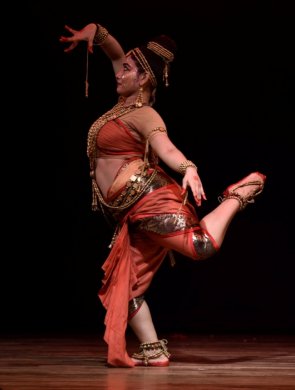 Pinki Mondal, Marga Natya  Akash Mallick, Marga Natya The last performance of the evening was Marga Natya by Akash Mallick and Pinki Mondal. Marga Natya is a style of dance that is being reconstructed from the Natya Shastra by Kalamandalam Piyal Bhattacharya for the last 15 years. According to the Natya Shastra, nritta, geeta and abhinaya are not just means of expression of entertainment but are instruments for acquiring a gradual self-realisation through performance. Hence this dance style is very different in its approach. The dancers were totally immersed in their dance, which had very serpentine movements. The dance had a hypnotic quality. Even the music was very different because old musical instruments were reconstructed and used. Akash and Pinki began their performance with a Shiva Stuti which is a dancer's first offering of nritta to the ultimate consciousness. Then they performed three short pieces. The audience sat still, mesmerized by the gait and beautiful movements of the dancers. This was the finale of the 20th Sanjukta Panigrahi Yuva Mahotsav. 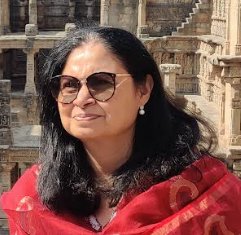 Lekha Merchant from Mumbai is an educationist and an avid lover of Indian classical dance having learnt Odissi for ten years. |